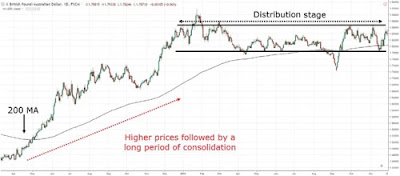What is phases in forex market?
The market doesn’t go up and down in a straight line. There’s an ebb and flow to it. If you pay close attention, you’ll realize the market moves in stages. This means if you know what stage the market is at, you’ll never have to second guess whether you should be buying or selling. Everything becomes clear to you.
How many types of stages or phases in a Forex Market?
- Accumulation Stage
- Advancing Stage
- Distribution Stage
- Declining Stage
Accumulation Stage
An accumulation stage occurs after a decline in price, and it looks like a range market within a downtrend. The logic behind this is the market can only go so low before the buyers step in and push the price higher. When that happens, you’ve got traders selling in the downtrend and traders buying at “cheap” prices. When these two forces collide, the market goes into an equilibrium, otherwise known as an accumulation stage.
Here are the characteristics of an accumulation stage:
- It occurs after the price has fallen over the last five months or more (on the daily timeframe).
- It looks like a range market with obvious areas of support and resistance within a downtrend.
- The 200-day moving average starts to flatten out.
- The price swings back and forth around the 200- day moving average.
Advancing Stage
The advancing stage occurs when the price breaks out of resistance (from the accumulation stage), which is otherwise known as an uptrend. This happens because the market can’t remain in a range forever. Eventually, one side of the market will dominate and that’s the start of a new uptrend (or the resumption of the downtrend). So for an advancing stage to occur, the buying pressure must overcome the selling pressure, which leads to the start of a new uptrend.
Here are the characteristics of an advancing stage:
- It occurs after the price breaks out of resistance in an accumulation stage. 34 Market Structure: Decoding the Secret Behavior of the Markets
- You’ll see a series of higher highs and lows.
- The price is above the 200-day moving average.
- The 200-day moving average is starting to point higher.
Distribution Stage
A distribution stage occurs after an advance in price, and it looks like a range market within an uptrend. The logic behind this is that the market can only go so high before the sellers come and short the markets. When this happens, you’ve got traders buying in an uptrend and traders shorting at “high” prices. When these two forces collide, the market goes into an equilibrium, otherwise known as the distribution stage.
Here are the characteristics of a distribution stage: 35 Market Structure: Decoding the Secret Behavior of the Markets
- It occurs after the price has risen for the last five months or more (on the daily timeframe).
- It looks like a range market with obvious support and resistance areas in an uptrend.
- The 200-day moving average starts to flatten out.
- The price whips back and forth around the 200-
day moving average.
Declining Stage
- Here are the characteristics of a declining stage:
- It occurs after the price breaks out of support in a distribution stage.
- You’ll see a series of lower highs and lows.
- The price is below the 200-day moving average.
- The 200-day moving average is starting to point lower.
How does Phases work actually in live market?
Phases are actually works very well in live market. that's why we’ll realize the market moves if you know what stage the market is at, you’ll never have to second guess whether you should be buying or selling. Everything becomes clear to you.
Summary
- An accumulation stage occurs after a decline in price, and it looks like a range market within a downtrend.
- The advancing stage occurs when the price breaks out of resistance (from the accumulation stage), otherwise known as an uptrend.
- A distribution stage occurs after an advance in price, and it looks like a range market within an uptrend.
- The declining stage occurs when the price breaks down of support (from the distribution stage), otherwise known as a downtrend.





